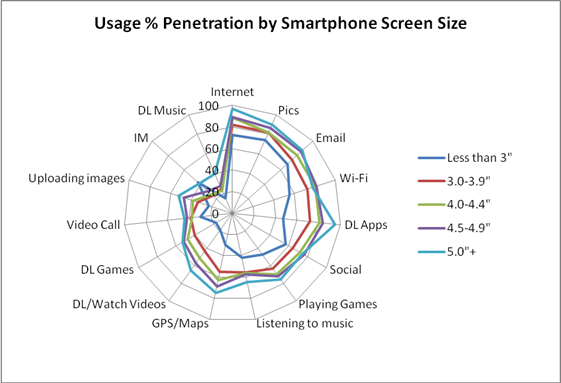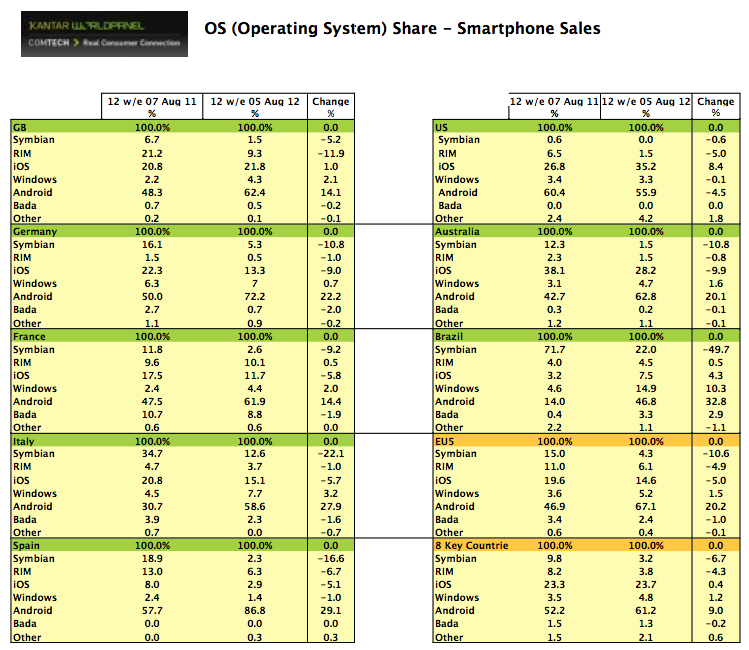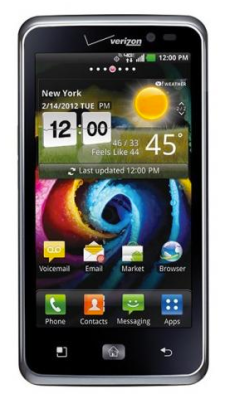We’ve seen a lot of images of an (alleged) iPhone coming soon with a bigger screen, and some numbers out from Kantar Worldpanel ComTech, the WPP-owned market analysts, underscore how a bigger iPhone may not be coming a moment too soon. In the last 12 weeks, it found that Android-based smartphones have continued to extend their lead over the rest of the pack, and the charge is being led by the big boys — literally.
Of all the Android devices that have been sold in the last three months, nearly one-third (29%) of them had a screen size of over 4.5 inches, with large-screened devices from Samsung, HTC, LG (pictured), Huawei and more. Apple’s current iPhone has a screen of 3.5 inches.
Kantar also found that Android’s market share in Europe has gone up by 20.2% in the past year; its devices now account for two-thirds of the smartphone market in Europe. In fact, as you can see in the table below, Android grew its share by double-digit percentages in just about every major market, except for the U.S., where it actually declined by 4.5% as iOS increased by nearly 9% over the same period a year ago.
Still, the U.S. appears to be an outlier at the moment (if not marching to the beat of a different drum altogether). Overall, there is not a single market among those surveyed by Kantar where Android does not have over 50% of all smartphone handset sales and is still growing stronger than the rest. And in some markets like Spain that percentage is even approaching 90%.
Across the eight most important markets, Kantar notes that Android has a share of 61%; while iOS is at 24%; and the rest all have 5% or less, led by Windows.
Going beyond straight handset sales, Kantar also takes a look at screen size and how that form factor impacts consumer behavior — the chief takeaway here being that the larger the screen the more likely a consumer will use that device for different services. (And if you think about long engagement times on something like the iPad tablet as the extreme of what happens when you have a large screen, this shouldn’t be too much of a surprise.)

“It is interesting to look at the impact a larger screen size has on how consumers use their smartphones, particularly as the line between tablets and smartphones becomes more blurred,” analyst Dominic Sunnebo writes.
This seems especially true for services that need more input from a user, or rely on visual elements. “Only 19% of consumers with a screen smaller than three inches download and watch videos, compared to 65% when the screen is five inches or more,” he writes.
Perhaps more importantly for carriers and handset makers, bigger screens as a result are also important for customer retention: that’s because the more engaged a consumer is with a device, the more likely they will stay loyal to a brand when they upgrade, Sunnebo says.
That has worked brilliantly for Apple up to now with its 3.5-inch devices — with iPhone owners being strong users of their devices, and also very loyal to the brand. The question is whether consumers will start to look for more, and if Apple will give it to them.

